Key takeaways:
- Trading indicators are essential tools for interpreting market trends, helping traders make informed decisions rather than relying on gut feelings.
- Utilizing a combination of indicators, such as moving averages, Bollinger Bands, and MACD, can enhance analysis and improve trading outcomes.
- Choosing the right indicators involves understanding personal trading styles and risk tolerance, as well as adapting settings for specific market conditions.
- Regularly analyzing indicator performance and patterns over time helps refine strategies and adapt to market changes, ensuring continuous improvement.
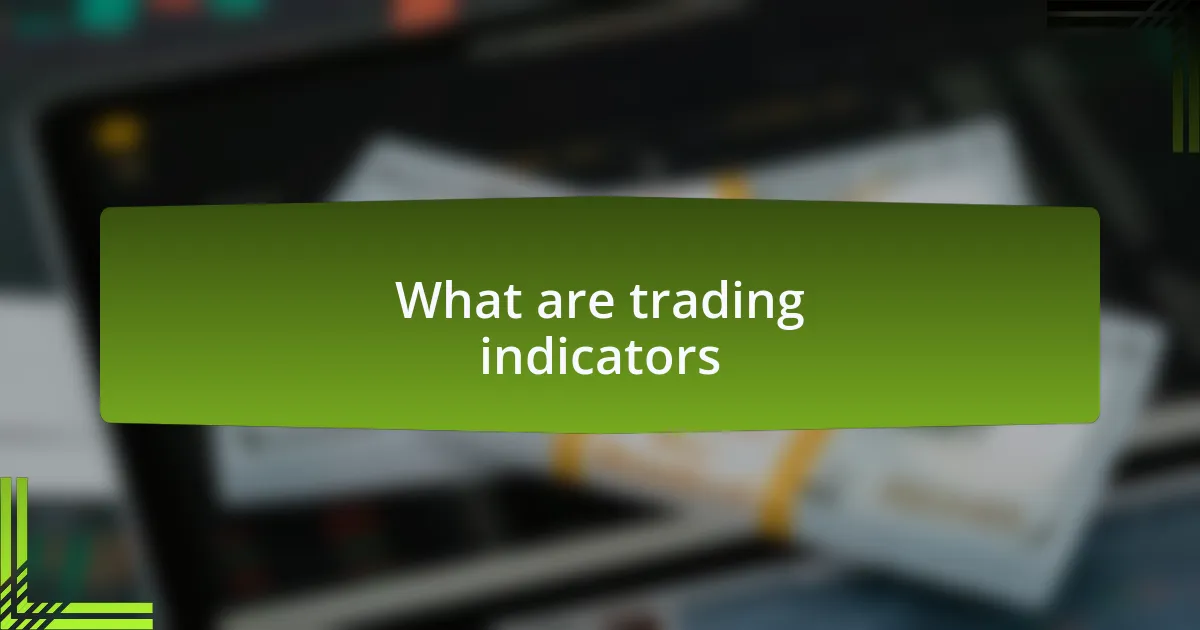
What are trading indicators
Trading indicators are mathematical calculations based on historical price, volume, or open interest data of a security. These indicators help traders make sense of market trends, offering insights that might not be apparent just by looking at price charts. I remember my early days in trading, feeling overwhelmed by all the data. It was the moment I discovered these indicators that I finally felt I had a clearer roadmap to navigate the market.
Different types of indicators serve various purposes, such as trend identification, momentum measurement, or even volatility assessment. For instance, I often rely on moving averages to identify potential market direction. Have you ever felt like you were guessing in the dark? Well, those moving averages brought a sense of confidence to my trades, transforming my approach from random speculation to informed decision-making.
As I delved deeper into trading, I realized that while indicators can illuminate potential opportunities, they should never be used in isolation. Each indicator paints part of the picture, but personal judgment and market context are what truly guide effective trading strategies. It’s like being an artist with a palette; the colors (or indicators) alone don’t create the masterpiece, it’s how I choose to apply them that makes all the difference.
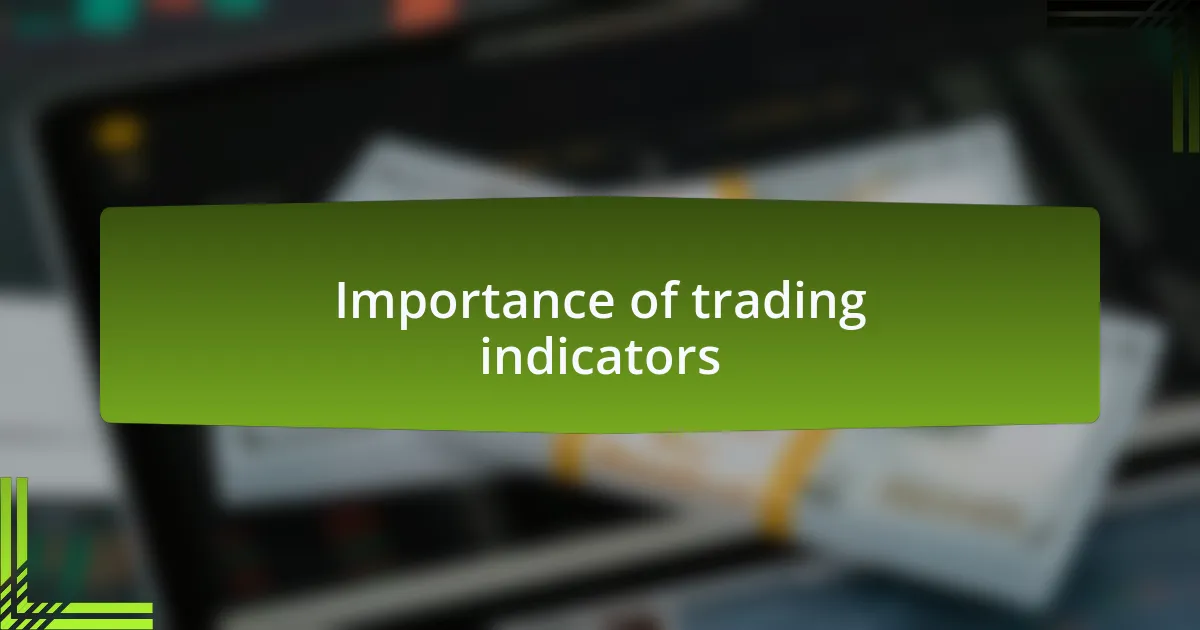
Importance of trading indicators
When I first experimented with trading indicators, I quickly learned that they serve as essential guides in the chaotic world of cryptocurrency trading. Imagine trying to find your way in a dense forest without a map; that’s how trading can feel without these tools. Indicators help to clarify my path, turning complex data into actionable insights that make all the difference when I’m deciding whether to buy or sell.
Using indicators has significantly boosted my trading confidence. I recall a time when a particular signal from the Relative Strength Index (RSI) prompted me to exit a position just in time. It was exhilarating to realize that I wasn’t just relying on gut feelings but was backed by careful analysis. Have you ever made an impulsive trade, only to regret not having a solid strategy? Indicators turn those hasty decisions into informed actions, which is crucial in the volatile cryptocurrency market.
The importance of trading indicators lies not just in their predictive power, but in how they empower traders like myself to stay disciplined. They provide a framework for my strategy, helping me resist emotional impulses that can lead to costly mistakes. I find that when I stick to my indicators, I navigate the ups and downs of the market with greater poise and assurance, treating each trade like a calculated step rather than a leap into the unknown.
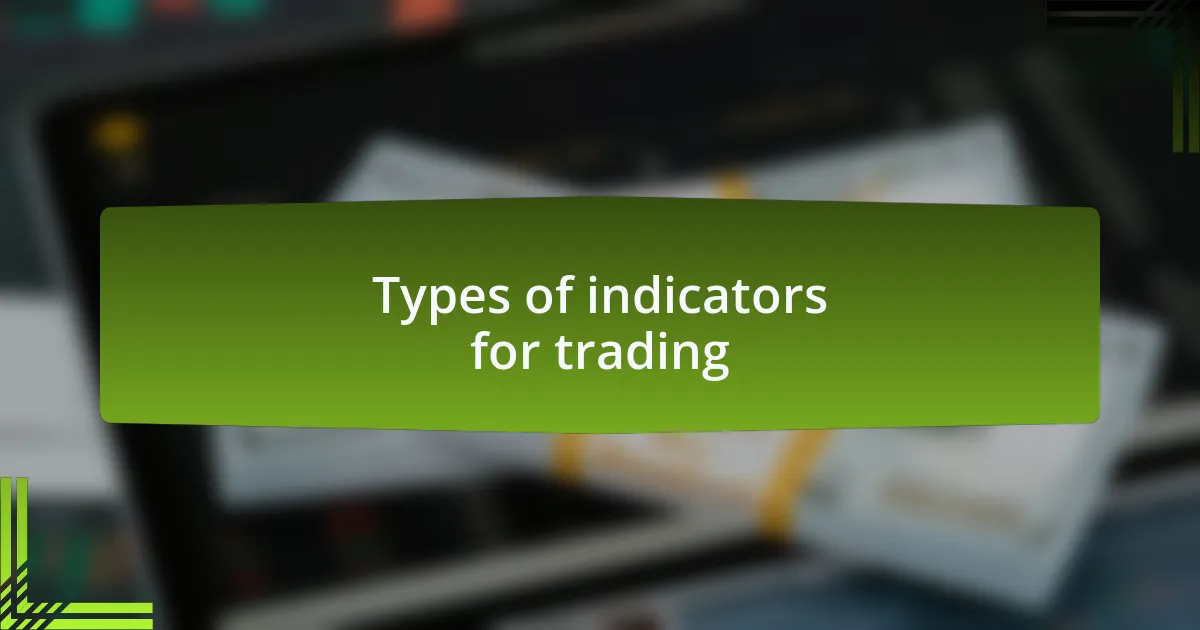
Types of indicators for trading
There are several types of indicators that I rely on in my trading journey. For instance, moving averages are one of my favorites. They smooth out price data, allowing me to identify the overall trend. When I see a cross between the short-term moving average and the long-term one, it often signals a change in market momentum. This tool has saved me from jumping into trades too early, which is something I used to struggle with.
Another indicator that I’ve found invaluable is the Bollinger Bands. They help me gauge market volatility by showing how far prices deviate from their average. During my last round of trading, I noticed the bands tightening, which typically indicates a price breakout. I decided to prepare for either a bullish or bearish move, and when it happened, I felt a surge of adrenaline mixed with satisfaction because my preparedness paid off.
Then there’s the MACD (Moving Average Convergence Divergence), which I often use to identify potential buy and sell signals. I remember it highlighting a divergence during a recent trade, prompting me to rethink my position. This moment made me appreciate how such indicators can act almost like a second pair of eyes—helping me see patterns I might otherwise overlook. Doesn’t it feel reassuring to have that extra layer of analysis at your fingertips?

Choosing the right indicators
Choosing the right indicators involves understanding not only what each one does but also how it complements my trading style. For instance, I often evaluate my risk tolerance and market conditions before selecting indicators. Why is that important? Because the wrong indicator can lead to unnecessary losses. I once relied too heavily on a single indicator during a volatile market phase, which resulted in a missed opportunity.
Navigating the selection process can be overwhelming. During my early trading days, I experimented with many indicators, which often felt like navigating a maze. However, I eventually discovered that combining momentum indicators with trend-following tools gives me a more rounded view. This balance has empowered me to make more informed decisions instead of merely reacting to the market.
Moreover, it’s crucial to align indicators with my trading goals. I still recall a time when I was caught up in the excitement of short-term trading and overlooked the need for a more foundational approach. After losing a bit of capital, I realized that understanding my objectives made choosing the right indicators much clearer. Isn’t it fascinating how self-awareness can shape our trading strategies?

My personal strategy using indicators
When it comes to my personal strategy using indicators, I’ve learned that simplicity can be powerful. I typically rely on a few key indicators, like the Moving Average Convergence Divergence (MACD) and Relative Strength Index (RSI), which help me identify entry and exit points with more clarity. I remember a particularly stressful trading session when I was flooded with data from multiple indicators; by simplifying my approach, I felt less overwhelmed and more in control of my decisions.
I also pay close attention to how these indicators interact with each other. For instance, when I notice the MACD crossing above its signal line while the RSI is below 70, it often signals a good buying opportunity for me. Reflecting on past trades, I can vividly recall moments when this combination helped mitigate risks, allowing me to confidently enter positions without second-guessing. Isn’t it interesting how patterns emerge when you trust the tools at your disposal?
Additionally, I regularly assess the effectiveness of my indicators through backtesting. This process has taught me valuable lessons, especially during various market cycles. For instance, I noticed that the performance of certain indicators fluctuated in bullish and bearish trends. By understanding these shifts, I can adapt my strategy to align with current market conditions, ultimately increasing my chances of success. How often do we overlook the value of historical data in shaping our future strategies?
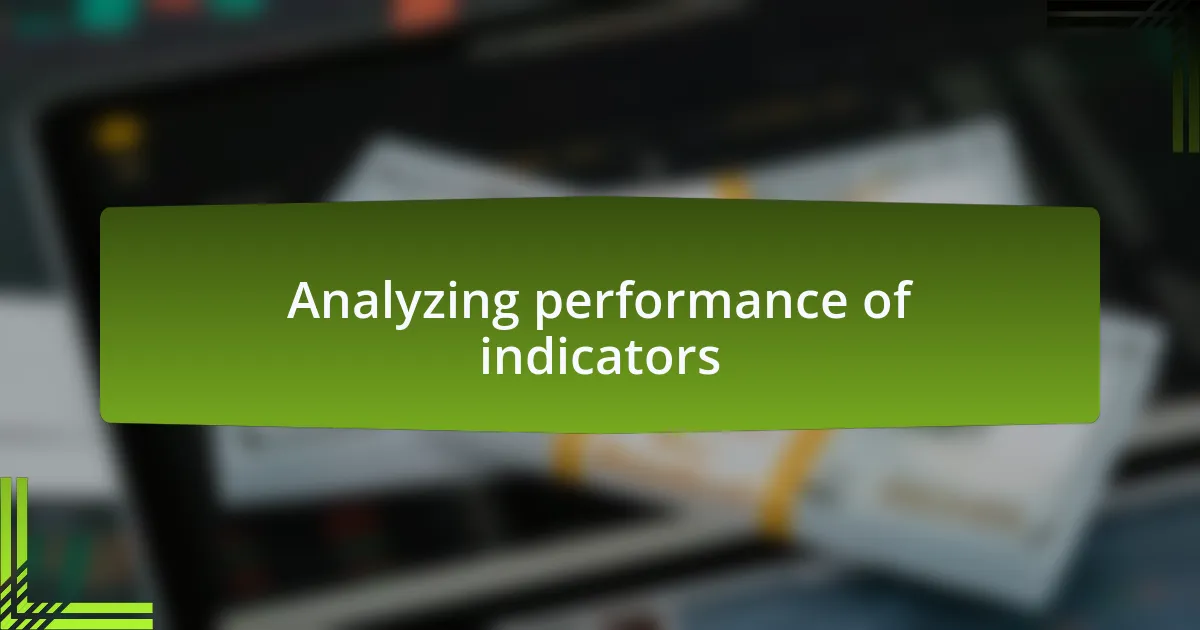
Analyzing performance of indicators
When I analyze the performance of my chosen indicators, I often find that context matters just as much as the indicators themselves. For example, there was a time when I was convinced that the RSI would always signal overbought or oversold conditions accurately. However, during a volatile market phase, I realized that I was misinterpreting its signals without considering external factors, like news events or market sentiment. How often do we get caught up in the numbers and forget the bigger picture?
Moreover, it’s essential to track the indicators’ performance over time, which I often do by maintaining a trading journal. After reflecting on my trades, I spotted a pattern: some indicators seemed to perform better during specific times of the day or even week, giving me critical insights into timing my trades more effectively. Have you ever noticed how market behavior changes at different times? This realization has been a game-changer for me.
I also take the time to compare the outcomes of trades based on separate indicators. Not long ago, I tested my strategy by measuring how often trades based on MACD signals were successful compared to those based on support and resistance levels. The findings were revealing and sometimes surprising! This ongoing analysis helps me refine my approach, ensuring my trading is always evolving—what are we if not learners in the rapidly changing world of cryptocurrency?
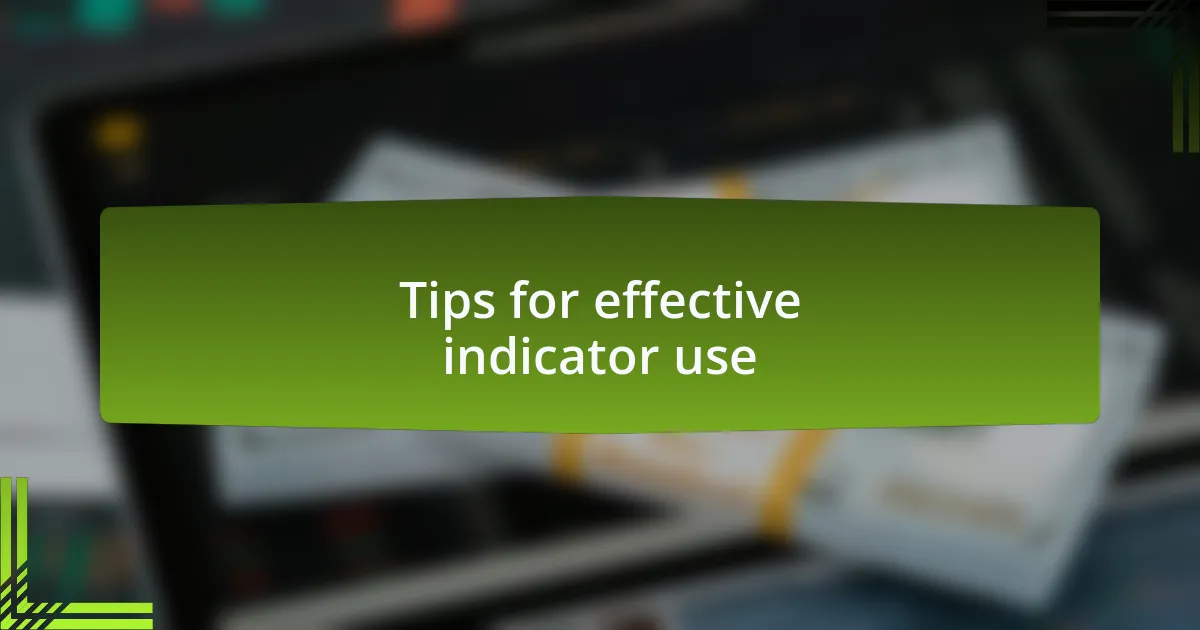
Tips for effective indicator use
When using indicators, one of the most valuable tips I can share is to avoid relying on a single indicator in isolation. Early in my trading journey, I heavily depended on the moving averages, thinking they’d guide me to perfect entry and exit points. It wasn’t until I started combining them with volume indicators that I began to see clearer trading signals. Have you ever felt like you were missing something, even when your indicators seemed strong? That’s when I realized the synergy between multiple indicators can offer a more comprehensive view.
Another practical strategy is to adapt your indicators to your unique trading style. I’ve experimented with various settings, and I’ve learned that sometimes the defaults just don’t cut it. For example, by tweaking the Period setting on my Bollinger Bands to suit a specific cryptocurrency’s volatility, I was able to capture price movements more accurately. Have you ever tried customizing your settings? It’s amazing how a small adjustment can lead to a big difference in results.
Lastly, I’ve discovered the importance of patience when interpreting signals. In my earlier days, I would jump at every signal, driven by the excitement of potential gains. However, I’ve learned that taking a moment to analyze the trend’s overall strength often leads to better decisions. Have you ever felt the itch to act immediately? I now wait for confirmation before making a move, which has been crucial in avoiding impulsive trades that don’t align with my strategy.